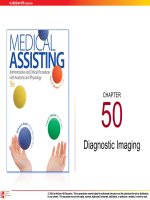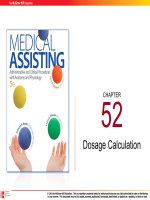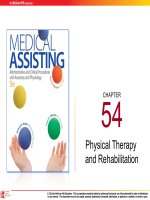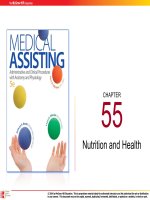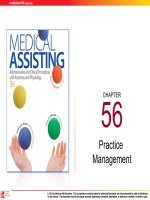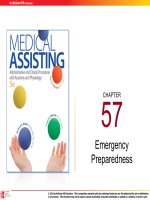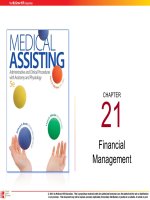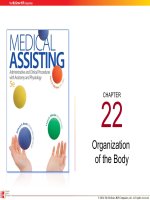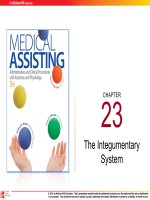Medical assisting Administrative and clinical procedures (5e) Chapter 57 Emergency preparedness
Bạn đang xem bản rút gọn của tài liệu. Xem và tải ngay bản đầy đủ của tài liệu tại đây (1.47 MB, 60 trang )
CHAPTER
57
Emergency
Preparedness
© 2014 by McGraw-Hill Education. This is proprietary material solely for authorized instructor use. Not authorized for sale or distribution
in any manner. This document may not be copied, scanned, duplicated, forwarded, distributed, or posted on a website, in whole or part.
57-2
Learning Outcomes
57.1 Discuss the importance of first aid during a
medical emergency.
57.2
Identify items found on a crash cart.
57.3
Recognize various accidental emergencies and how
to deal with them.
57.4
List common illnesses that can result in medical
emergencies.
57.5
Identify less common illnesses that can result in
medical emergencies.
© 2014 by McGraw-Hill Education. This is proprietary material solely for authorized instructor use. Not authorized for sale or distribution
in any manner. This document may not be copied, scanned, duplicated, forwarded, distributed, or posted on a website, in whole or part.
57-3
Learning Outcomes
57.6 Discuss your role in caring for people with
psychosocial emergencies.
57.7 Carry out the procedure for calming a patient who is
under extreme stress.
57.8 Discuss ways to educate patients about how to
prevent and respond to emergencies.
57.9 Illustrate your role in responding to natural disasters
and pandemic illness.
57.10 Discuss your role in responding to acts of
bioterrorism.
© 2014 by McGraw-Hill Education. This is proprietary material solely for authorized instructor use. Not authorized for sale or distribution
in any manner. This document may not be copied, scanned, duplicated, forwarded, distributed, or posted on a website, in whole or part.
57-4
Introduction
• Emergencies
– Acute illnesses
– Injuries
– Phone calls from
patients with urgent
problems
– Disasters
The medical assistant must be prepared to
determine the urgency of and handle any
emergencies that arise.
© 2014 by McGraw-Hill Education. This is proprietary material solely for authorized instructor use. Not authorized for sale or distribution
in any manner. This document may not be copied, scanned, duplicated, forwarded, distributed, or posted on a website, in whole or part.
57-5
Understanding Medical Emergencies
• Any situation requiring immediate care
• First aid
– Save a life
– Reduce pain
– Prevent further injury
– Reduce the risk of permanent disability
– Increase the chance of early recovery
© 2014 by McGraw-Hill Education. This is proprietary material solely for authorized instructor use. Not authorized for sale or distribution
in any manner. This document may not be copied, scanned, duplicated, forwarded, distributed, or posted on a website, in whole or part.
57-6
Apply Your Knowledge
Why is it important to perform first aid in a medical
emergency?
ANSWER: First aid can:
Save a life
Prevent further injury
Reduce pain
Reduce risk of permanent disability
Increase the chance of early recovery
© 2014 by McGraw-Hill Education. This is proprietary material solely for authorized instructor use. Not authorized for sale or distribution
in any manner. This document may not be copied, scanned, duplicated, forwarded, distributed, or posted on a website, in whole or part.
57-7
Preparing Medical Emergencies
• Preparing the Office
– Know what is expected of you
– Post emergency telephone
numbers
• At every telephone
• On the Crash cart or first
aid tray
© 2014 by McGraw-Hill Education. This is proprietary material solely for authorized instructor use. Not authorized for sale or distribution
in any manner. This document may not be copied, scanned, duplicated, forwarded, distributed, or posted on a website, in whole or part.
57-8
Preparing the Office (cont.)
• Provide information to EMS
– Your name and location
– Nature of the emergency
– Number of people needing help
– Condition of the injured or ill patient(s)
– Summary of the first aid already given
– Directions to your location
Do not hang up until the dispatcher gives
you permission to do so.
© 2014 by McGraw-Hill Education. This is proprietary material solely for authorized instructor use. Not authorized for sale or distribution
in any manner. This document may not be copied, scanned, duplicated, forwarded, distributed, or posted on a website, in whole or part.
57-9
Preparing for Medical Emergencies (cont.)
• Emergency and first-aid supplies
– Crash cart / tray
• Basic drugs, supplies, and equipment for
medical emergencies
• First-aid kit for minor injuries and ailments
– Must be routinely checked and
restocked
© 2014 by McGraw-Hill Education. This is proprietary material solely for authorized instructor use. Not authorized for sale or distribution
in any manner. This document may not be copied, scanned, duplicated, forwarded, distributed, or posted on a website, in whole or part.
57-10
Guidelines for Handling Emergencies
• Medical assistants
– Recognize lifethreatening condition
– Take appropriate
actions
• Patient emergencies
– Assess the situation
– PPE
– Assess patient
• Initial assessment
1. General impression
2. Level of
responsiveness
3. Assess CABs
4. Urgency of condition
5. Focused exam
6. Document
© 2014 by McGraw-Hill Education. This is proprietary material solely for authorized instructor use. Not authorized for sale or distribution
in any manner. This document may not be copied, scanned, duplicated, forwarded, distributed, or posted on a website, in whole or part.
57-11
Guidelines for Handling Emergencies (cont.)
• Telephone emergencies
– Triaging
• Classification of injuries
• Follow office protocols
– General guidelines
• Stay calm
• Reassure the patient
• Act confidently
© 2014 by McGraw-Hill Education. This is proprietary material solely for authorized instructor use. Not authorized for sale or distribution
in any manner. This document may not be copied, scanned, duplicated, forwarded, distributed, or posted on a website, in whole or part.
57-12
Guidelines for Handling
Emergencies (cont.)
• Personal protection
– Take precautions to reduce chance of
exposure during an emergency
– Follow Standard Precautions and use PPE
– Minimize splashing
– Wash hands
– Keep PPE in first-aid kit at home and work
© 2014 by McGraw-Hill Education. This is proprietary material solely for authorized instructor use. Not authorized for sale or distribution
in any manner. This document may not be copied, scanned, duplicated, forwarded, distributed, or posted on a website, in whole or part.
57-13
Handling Emergencies (cont.)
• Documentation
– Assessment
– Treatment given
– Patient response
– If patient transported, location
of facility
© 2014 by McGraw-Hill Education. This is proprietary material solely for authorized instructor use. Not authorized for sale or distribution
in any manner. This document may not be copied, scanned, duplicated, forwarded, distributed, or posted on a website, in whole or part.
57-14
Apply Your Knowledge
What are the steps of the initial assessment of a
patient in an emergency?
Correct
ANSWER: The steps of the initial assessment are:
! patient
1. Form a general impression of the
2. Determine the patient’s level of responsiveness
3. Assess CABs
4. Determine the urgency of condition
5. Perform a focused exam
6. Document findings/report to physician or EMT
© 2014 by McGraw-Hill Education. This is proprietary material solely for authorized instructor use. Not authorized for sale or distribution
in any manner. This document may not be copied, scanned, duplicated, forwarded, distributed, or posted on a website, in whole or part.
57-15
Accidental Injuries
• Provide first aid
• Be able to help in emergency situations
– Bites and stings
– Burns
– Choking
– Eye and ear injuries
– Falls, fractures, dislocations
– Head injuries
© 2014 by McGraw-Hill Education. This is proprietary material solely for authorized instructor use. Not authorized for sale or distribution
in any manner. This document may not be copied, scanned, duplicated, forwarded, distributed, or posted on a website, in whole or part.
57-16
Bites and Stings
• Animal bites
– Bruise, tear, puncture
– Cleanse wound, apply ointment and dry,
sterile dressing
• Insect stings
– Remove stinger
– Wash area, apply ice
© 2014 by McGraw-Hill Education. This is proprietary material solely for authorized instructor use. Not authorized for sale or distribution
in any manner. This document may not be copied, scanned, duplicated, forwarded, distributed, or posted on a website, in whole or part.
57-17
Bites and Stings (cont.)
• Snake bites
– May need antivenin
– Immobilize and position below heart
• Spider bites
– Refer to physician
– Wash area, apply ice,
and keep below heart level
© 2014 by McGraw-Hill Education. This is proprietary material solely for authorized instructor use. Not authorized for sale or distribution
in any manner. This document may not be copied, scanned, duplicated, forwarded, distributed, or posted on a website, in whole or part.
57-18
Burns
• Thermal
• Chemical
– Hot liquids, steam,
flame, etc.
– Water, wet cloth, or
blanket
– Remove chemical
– Wash with cool
water for 15
minutes
– Cover with dry,
sterile dressing
© 2014 by McGraw-Hill Education. This is proprietary material solely for authorized instructor use. Not authorized for sale or distribution
in any manner. This document may not be copied, scanned, duplicated, forwarded, distributed, or posted on a website, in whole or part.
57-19
Burns (cont.)
• Electrical
– Entry and exit sites
– Tissue damage
along current’s
pathway
• Classifications of
burns – severity
– Depth and extent
– Source of burn
– Age of patient
– Body area burned
– Other illness or
injuries
© 2014 by McGraw-Hill Education. This is proprietary material solely for authorized instructor use. Not authorized for sale or distribution
in any manner. This document may not be copied, scanned, duplicated, forwarded, distributed, or posted on a website, in whole or part.
57-20
Choking
• Food or foreign object blocks the trachea or
windpipe
• Unable to speak
• Universal sign – hand up to
throat with a fearful look
Be prepared to act promptly!
© 2014 by McGraw-Hill Education. This is proprietary material solely for authorized instructor use. Not authorized for sale or distribution
in any manner. This document may not be copied, scanned, duplicated, forwarded, distributed, or posted on a website, in whole or part.
57-21
Accidental Injuries (cont.)
• Ear trauma
– Lacerations, cuts
– Severed ear ~ transport with patient
• Eye trauma
– Care depends on severity
– Foreign object in the eye
© 2014 by McGraw-Hill Education. This is proprietary material solely for authorized instructor use. Not authorized for sale or distribution
in any manner. This document may not be copied, scanned, duplicated, forwarded, distributed, or posted on a website, in whole or part.
57-22
Accidental Injuries (cont.)
• Falls
– Have patient examined before moving
– Stabilize neck if injury suspected
– Minor falls, notify the physician
– Document
© 2014 by McGraw-Hill Education. This is proprietary material solely for authorized instructor use. Not authorized for sale or distribution
in any manner. This document may not be copied, scanned, duplicated, forwarded, distributed, or posted on a website, in whole or part.
57-23
Fractures and Dislocations
• Fracture – break in the bone
• Dislocation – displacement of bone end from the joint
• Immobilization
– Sling or splint
– Cast
© 2014 by McGraw-Hill Education. This is proprietary material solely for authorized instructor use. Not authorized for sale or distribution
in any manner. This document may not be copied, scanned, duplicated, forwarded, distributed, or posted on a website, in whole or part.
57-24
Fractures and Dislocations
• Sprain
– Partial tearing of a ligament
supporting a joint
– Splint and apply ice
• Strain – muscle injury
from overexertion
© 2014 by McGraw-Hill Education. This is proprietary material solely for authorized instructor use. Not authorized for sale or distribution
in any manner. This document may not be copied, scanned, duplicated, forwarded, distributed, or posted on a website, in whole or part.
57-25
Head Injuries
• Concussion – jarring injury of
the brain
• Severe head injuries –
contusions, fractures, and
intracranial bleeding
• Scalp hematoma – bleeding
under skin on head
• Scalp lacerations – often bleed
profusely
© 2014 by McGraw-Hill Education. This is proprietary material solely for authorized instructor use. Not authorized for sale or distribution
in any manner. This document may not be copied, scanned, duplicated, forwarded, distributed, or posted on a website, in whole or part.
